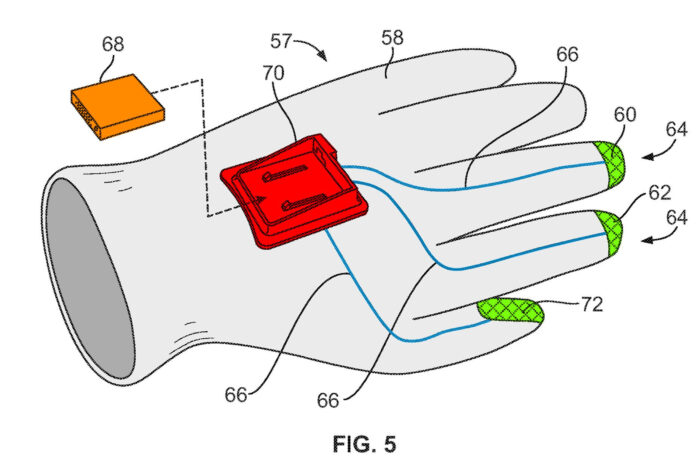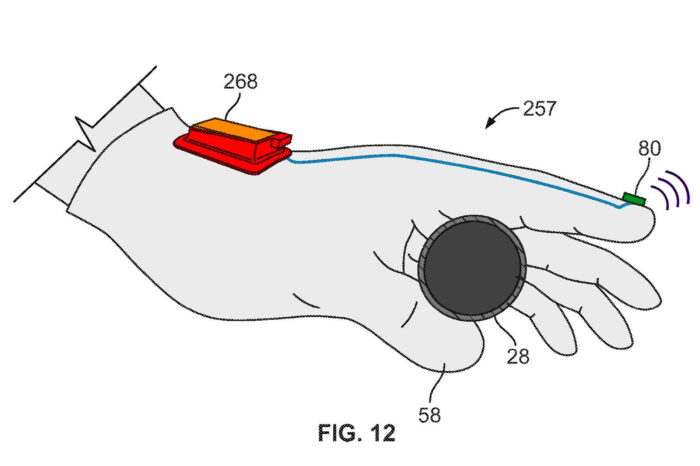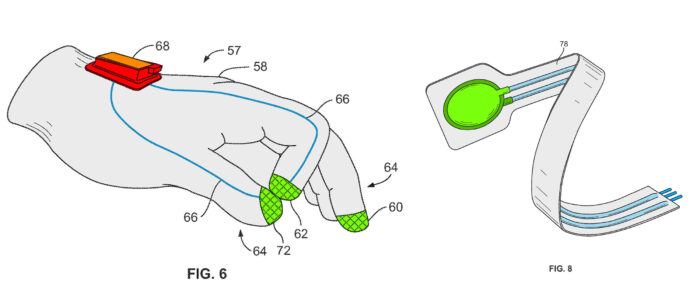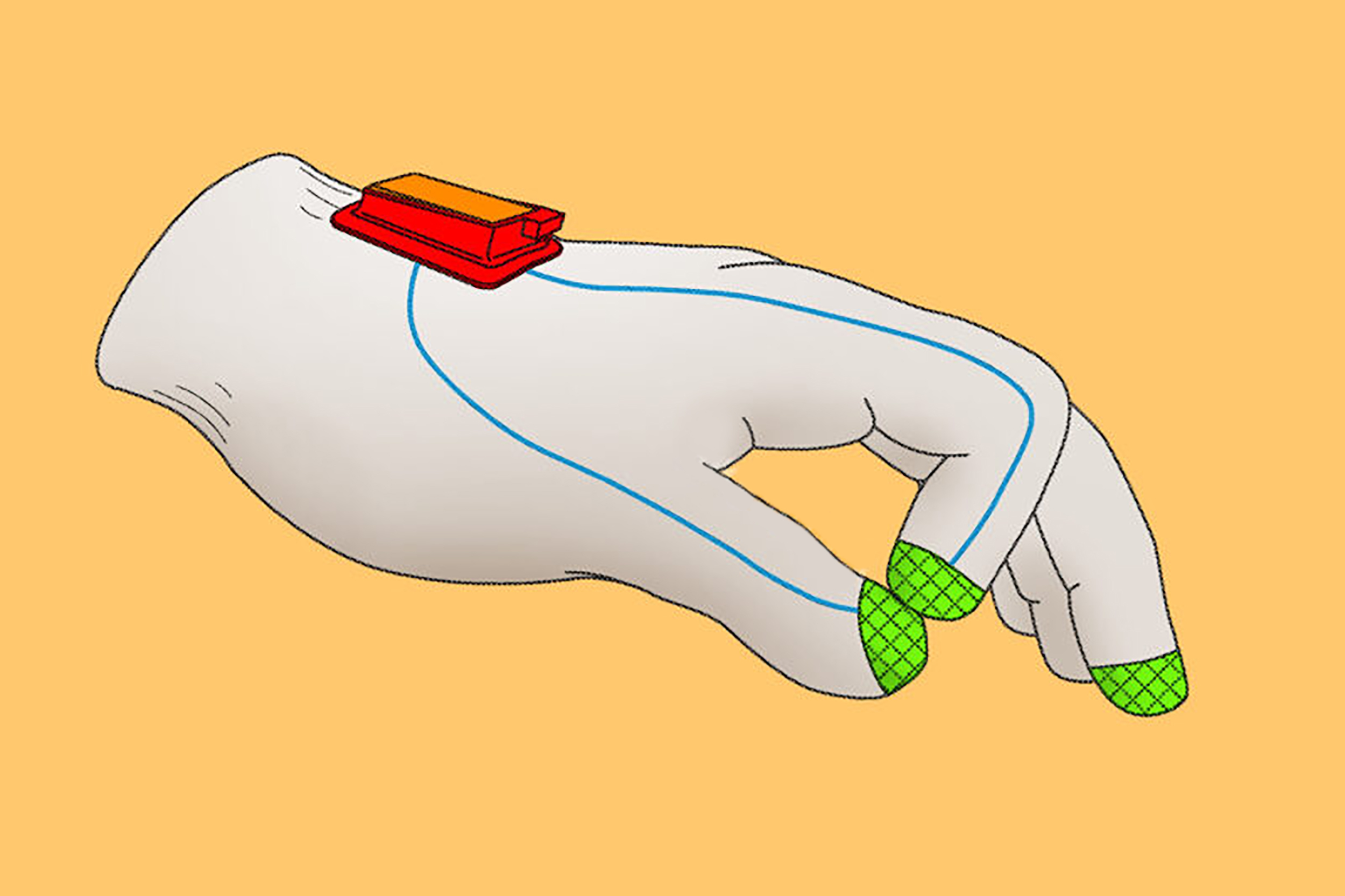A version of this article originally appeared on BikeRumor!
On April 1, 2021, SRAM filed a patent describing wearable wireless shifters, or suspension control remotes, integrated directly into a rider’s gloves.
It details pressure-sensitive resistors built into the glove to wirelessly actuate derailleur shifting in a highly programmable way. Flicking or extending a finger, or compression of the fingertip against the grip or thumb tip, could signal a shift.
Such technology would allow a rider to shift through gears no matter their hand positioning. It potentially makes shifting quicker, easier, and possibly safer — if, of course, SRAM executes it well. It could also shave grams for marginal gains, with the potential of actuating front and rear shifting with one hand.
Here’s a closer look at the proposition.

SRAM’s Wearable AXS Shifter
The patent filing (US11703118B2) shows several drawings wherein a glove is furnished with one or more pressure-sensitive resistors or accelerometers (green), positioned on the pad of each finger or on the tip of each finger — seen in Fig. 5 above. Each one is wired up to an electronic control unit (orange) that is affixed in a tool-free fashion to the back of the glove via a mount (red).
SRAM describes how the electronic control unit can wirelessly communicate with an electronic derailleur or an electronic suspension adjuster to shift gears or switch between damping modes. Nothing special there. It’s the proposed method of signaling to the control unit to actuate shifting that is somewhat futuristic.
In reference to the use of an accelerometer to actuate a shift, the patent reads, “Such devices have many advantages as shift control sensors. They are low-power, very durable, and do not require contact with any other object to work. The sensor senses its relative position in space as a function of gravity and change of position as a function of acceleration. For example, the orientation of the device relative to the ground can be used to indicate a shift signal.”

The patent outlines a number of ways in which this wearable shifter could trigger a shift:
- Flicking of the index finger
- Touching the thumb and any of the other fingers together, perhaps with some threshold force
- Hyper-extension of any of the five digits beyond the normal operating range
- Compression of the tips of the fingers rather than the pads
- Any combination of the above actions
SRAM could make this system very customizable. Riders could program the control unit to respond to unique triggers that they find most intuitive — or easy and safe to execute.
An excerpt from the patent document details one way in which the inventors foresee it in use:
“A right-hand actuator would cause a shift of the rear derailleur in one direction, a left-hand actuator would cause a shift of the rear derailleur in the other direction and activating both actuators simultaneously would toggle the front derailleur to the other of its current inboard or outboard position.”
Sounds like the normal thinking behind eTap shift logic, just without the need for shift levers.
The patent document states that movement used to trigger a shift should not be encountered in normal riding to prevent unintended shifts.
The wide variety of hand and finger shapes would certainly need to be accounted for in any application of this technology. There would need to be a wide range of adjustability to fit the riding population accurately.
Ensuring those pressure-sensitive resistors or accelerometers are positioned as intended would be fundamental to its success. It seems reasonable that SRAM may need many sizes or even fully custom gloves (aka shifters) to roll this out.
Glove-Mounted AXS Shifters for Road Cycling

This wearable shifter concept described by SRAM seems most applicable to road riding. Most of the images seen throughout the patent document depict a road bike.
But how many roadies do you know that regularly wear full-finger gloves? Will you need to wear full-finger gloves on those hottest summer road rides? And what happens when winter comes and you need thicker gloves?
There are at least three different hand positions that a road rider might use at any moment. They could be in a low aero position in the drops, in a more relaxed position on the tops, or they could be in between those extremes with their hands on the hoods.
It would be most convenient and safe to perform a shift from any of those three hand positions without having to move to a new position — or to let go of the grip on the bar. You can run SRAM eTap AXS Wireless Blips in any location, within reason, and you can have several. That gives you multiple locations on the bar from which to trigger a shift.
But there are downsides to that. Adding more shifters means adding more wires (read: weight), and it will also clutter the cockpit, reducing the aesthetic value.
I’m not much of a road cyclist, but I imagine that neither of those downsides is palatable to anyone counting grams. SRAM’s glove-integrated shifter technology gets around all of this by putting the shifter on the rider rather than the bar.
Another advantage of this technology is that it could ease braking and shifting simultaneously. We wonder if that could present an advantage to a rider during a descent. Descending on the drops, the rider might be braking hard before a corner. Meanwhile, they could send a single finger into full extension, changing to an easier gear. This means that they’re in a better gear for getting back up to speed once they’re through the corner.
Not every mountainous stage of the Tour de France has been won on the climbs. So, if there is another marginal gain here, you can be sure riders and teams will check it out.
Wearable Wireless Shifters and Remotes for Mountain Biking
Though the advantages are perhaps less obvious, it’s possible that SRAM could implement a glove-integrated actuator off-road, too. The technology could be used as described above. But mountain biking is a little less predictable than road riding. And at least on social rides, a lot more of a stop-start affair. This all presents more instances of accidentally triggering a shift.
In a more controlled, competitive environment, however, it could be advantageous in other ways. While the patent focuses on gear changing, it also mentions potential use as a remote for suspension adjustment. SRAM doesn’t allude to it in the patent, but why not for an AXS dropper post, too?

Imagine switching suspension from lock to open mode by applying pressure to the tip of your finger against the grip. Or by pressing the tip of your index finger into the tip of your thumb. Or dropping or popping your dropper seat post by doing the same. This could offer an ergonomic advantage over a handlebar-mounted remote, allowing them to maintain a more consistent grip.
Certainly, there are arguments both ways as to whether the wearable solution would be safer and easier. Or it could be more clumsy and dangerous than handlebar-mounted remotes. But, we trust that SRAM has the financial capacity and expertise to collect the necessary data to learn more either way. And we already know its top-sponsored MTB athletes have been customizing AXS buttons for years.
So, Why Not Voice-Activated Shifting, Too?

A final method that SRAM threw in as almost an afterthought is voice-activated shifting. Fig. 15 shows a wireless control device (orange) and microphone (84) rigged to a rider’s helmet. As we can all operate our smartphones by speaking to them, it seems plausible that we could trigger a gear shift or suspension adjustment via the same method. This is entirely hands-free and arguably the safest method, if not the sexiest, of the lot. Hey Siri, make it easier for me to get up that next climb!







